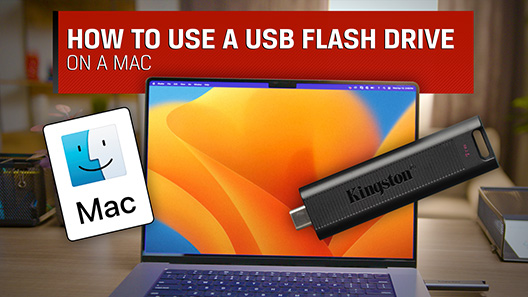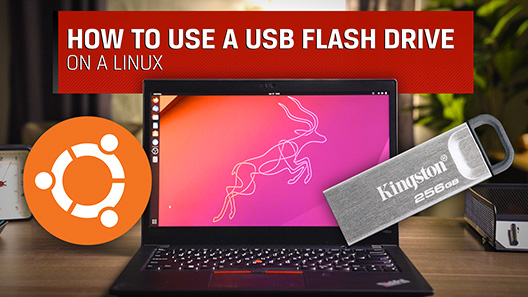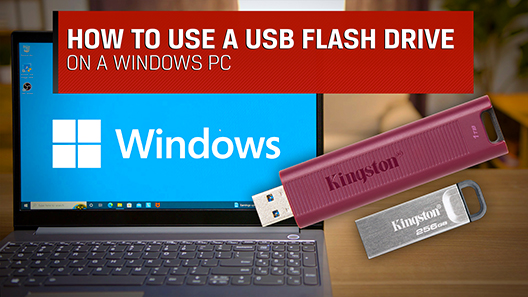
DataTraveler microDuo 3C USB Type-A Flash Drive - Support
Resources
Videos
Frequently Asked Questions
This is common for flash storage, whether internal SSD, Flash Card, or external USB storage, and is due in part to a variance in how flash memory vs spinning platter hard drive manufacturers calculate megabyte. Hard drive manufacturers calculate a megabyte (or 1,000x1,000 bytes) as 1,000KBs, whereas the binary calculation for flash-based storage is 1,024KBs.
Example: For a 1TB flash-based storage device, Windows will calculate it as having a capacity of 931.32GB. (1,000,000,000,000÷1,024÷1,024÷1,024=931.32GB).
Furthermore, Kingston reserves some of the listed capacity for formatting (e.g., File Allocation Table) and other functions such as firmware and/or controller-specific information, and thus some of the listed capacity is not available for data storage.
FAQ: KDT-010611-GEN-06
The files on your Data Traveler microDuo can be accessed via your Android device’s file explorer. The file explorer can be found in the apps menu of your Android device. If your device does not have a file explorer we recommend you download your preferred file explorer app from Google Play™.ES File Explorer is available for free download.
FAQ: KDT-022714-DUO-01
Please ensure the microDuo USB Drive is fully inserted into the microUSB port on your mobile device. Some mobile devices may have protective cases that could interfere with the full and proper connection between Data Traveler microDuo and the microUSB port of a mobile device. You may have to remove the protective case on your mobile device to obtain a full and proper connection.
Data Traveler microDuo is designed to be compatible with USB-On-The-Go (OTG) enabled Android devices. Please verify your mobile device is compatible with the microDuo USB Drive and you have properly connected the drive to your Android device. See compatibility list here www.kingston.com/support/technical/otg_compatibility
Some microDuo USB Drives (64GB and higher) come preformatted using exFat file system and certain Android devices do not support exFat. In this case, please format the drive in Fat32 file system using your computer.Some mobile devices may disable power to the microDuo USB drive when the device's battery reaches a critically low level. This may cause the microDuo USB Drive to be unrecognizable until the battery is charged and the device has rebooted.
FAQ: KDT-022714-DUO-02
- Access the settings menu of your device
- Access the Storage Menu
- Select Unmount USB OTG storage
- Select OK if prompted
Note: After selecting Unmount USB OTG storage, some mobile devices, will prompt the question, “Unmount SD card?”.This prompt is default for some mobile devices. Please make sure you selected, Unmount USB OTG storage, and select OK.
FAQ: KDT-022714-DUO-03
Sorry, Apple iOS and Google Nexus devices do not have USB On-The-Go (OTG) support. For a list of compatible devices please visit https://www.kingston.com/us/usb/otg
FAQ: KDT-022714-DUO-04
This prompt is default for some mobile devices. Please make sure you selected, Unmount USB OTG storage or Format USB OTG storage, and select OK.
FAQ: KDT-031714-DUO-05
Unfortunately this unit does not have any security or write protection feature. If you receive a write protection message with this drive, check for the following:
- Verify that you are allowed to write to removable storage devices. There may be a security setting in the OS that disables write access to removable storage devices.
- Make sure you have not enabled write protection on the drive by using a third party software.
- If none of the above apply, the drive may be defective. Contact Kingston Technical Support for further assistance.
FAQ: KDT-011411-PW-08
If you have data on the DataTraveler that is important to you, we strongly recommend that you use one of the two possible ways for data recovery (see below). Kingston does not offer data recovery services. For more information on our warranty policy please visit http://www.kingston.com/company/warranty.asp
- Contact a company that specializes in data recovery services such as Driver Savers at www.drivesavers.com and Ontrack at www.ontrack.com just to name a couple or you can do a search on Google for data recovery.
- Go to www.download.com and do a search for data recovery and download one of the many utilities for data recovery which are fairly simple to use. We suggest trying one of the free versions as they work just as well as the paid versions. However for the possibilities for this option to work, the computer must assign a drive letter to the device. Even so it's not a guarantee. If not then option #1 would be your best bet.
KDT-012611-GEN-25
FAQ: KDT-012611-GEN-25
Although it is possible to boot from the DataTraveler, it is not a feature Kingston supports.These drives are intended as storage devices.
FAQ: KTD-082913-GEN-27
FAQ: KGF-022811-GEN-02
Windows assigns new drives to the next available physical drive. It will sometimes take the same drive letter as a network drive for this reason. This is a common problem with removable storage devices.
To resolve this, go to Control Panel>Administrative Tools>Computer Management>Disk Management. Note the drives on the right windowpane. See if the Kingston (x) is recognized. (x) denotes the drive letter that Windows assigned for the DataTraveler.
If the DataTraveler is using the same drive letter as one of the other drives, right-click the Kingston Drive letter and click on "Change Drive letter and Paths".
On the next dialog box click on the "Change" button and assign a drive letter that is not currently being used.
Note: Do not manually change drive letters if you have a "Privacy" Data traveler that assigns two drive letters for the device.
FAQ: KDT-010611-GEN-03
FAQ: KDT-010611-GEN-14
ReadyBoost is a Windows feature having the ability to utilize USB flash storage space as disk caching to improve system performance. Unfortunately, DataTraveler USB drives do not support Windows ReadyBoost.
FAQ: KDT-010611-GEN-11
Windows may not recognize the MacOS Extended or Standard file system. To resolve, format the drive in MacOS DOS so that it can be used in both environments.
WARNING: Formatting will erase all of the data on the DataTraveler. Back up your data before proceeding.
- Insert the DataTraveler into the Mac OS X machine and wait for it to mount.
- Click on the "GO" option on the menu bar.
- Double-click on Utilities (If you do not see Utilities, double-click on Applications and then double-click on the Utilities folder.)
- Double-click on the Disk Utility icon.
- On the Disk Utility Dialog box, click once on the Kingston DataTraveler active partition.
Note: There will be two listings for the DataTraveler, the first one is the active partition and the second is the volume label. - Click the erase tab located on the right side of the screen.
- Using the Volume Format drop-down, select "MS-DOS File System" from the list.
- Click Erase.
Be aware MacOS 10.6.5 will support full read and write access to exFAT formatted drives. So formatting the drive using exFAT file system may also resolve this problem. MacOS still has read only access to NTFS formatted drives.
Some devices (MP3 players, digital photo frames, etc) will not read NTFS or exFAT file systems.
Also Windows XP and Vista will require an update in order to access exFAT.
FAQ: KDT-010611-GEN-18
Yes, this DataTraveler is supported by Linux as long as you have Linux Kernel 2.6.x and above.
Please note: If the DataTraveler comes with software, it will not function with Linux. Only the drive itself is compatible with Linux.
FAQ: KDT-011411-DRV-02
In Macs you first have to empty out the trash can in order to regain the space back. You may have to re-plug the drive back in after emptying out the trash.
Should this not work then a complete format of the device should be done. Please follow these instructions for formatting your Kingston device.
WARNING: Formatting will erase all your data so please make sure you have a copy before proceeding.
- Go to Go > Applications > Utilities and Open Disk Utility.
- Choose your drive from the left panel and then click Erase on the right.
- Select a Volume Format.Choosing MS-DOS File System will allow the drive to work on the Mac and Windows operating systems. If used only in a Mac then select Mac OS Extended as the Volume Format.
- Click Erase.
FAQ: KDT-010611-GEN-04
Windows may not recognize the MacOS Extended or Standard file system. To resolve, format the drive in MacOS DOS so that it can be used in both environments.
WARNING: Formatting will erase all of the data on the DataTraveler. Back up your data before proceeding.
- Insert the DataTraveler into the Mac OS X machine and wait for it to mount.
- Click on the "GO" option on the menu bar.
- Double-click on Utilities (If you do not see Utilities, double-click on Applications and then double-click on the Utilities folder.)
- Double-click on the Disk Utility icon.
- On the Disk Utility Dialog box, click once on the Kingston DataTraveler active partition. Note: There will be two listings for the DataTraveler, the first one is the active partition and the second is the volume label.
- Click the erase tab located on the right side of the screen.
- Using the Volume Format drop-down, select "MS-DOS File System" from the list.
- Click Erase.
Be aware MacOS 10.6.5 will support full read and write access to exFAT formatted drives. So formatting the drive using exFAT file system may also resolve this problem. MacOS still has read only access to NTFS formatted drives.
Some devices (MP3 players, digital photo frames, etc) will not read NTFS or exFAT file systems.
Also Windows XP and Vista will require an update in order to access exFAT.
FAQ: KDT-010611-GEN-07



